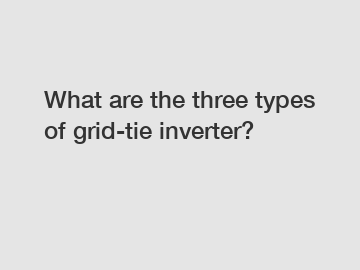Feb. 05, 2024
Energy
Goto Sunplus to know more.
What are the three types of grid-tie inverter?
Grid-tie inverters play a crucial role in harnessing solar energy and ensuring its efficient integration into the electric grid. By converting the direct current (DC) produced by solar panels into alternating current (AC), these inverters enable the utilization of solar power for homes and businesses. There are three main types of grid-tie inverters: string inverters, microinverters, and power optimizers. Let's take a closer look at each of them and understand their distinct characteristics.

1. String Inverters:
String inverters are the most traditional and commonly used type of grid-tie inverters. As the name suggests, these inverters are generally installed in a string configuration, where multiple solar panels are connected in series. The DC power generated by the solar panels is sent through a string of panels to the string inverter, which then converts it into usable AC power.
One of the advantages of string inverters is their cost-effectiveness. Since only one inverter is needed for an entire array of solar panels, the overall system cost is relatively low. Additionally, string inverters often come with built-in MPPT (Maximum Power Point Tracking) algorithms, optimizing the efficiency of power conversion.
However, there are some limitations to string inverters. The performance of the whole system is dependent on the lowest-performing panel in the string. Hence, if one panel experiences shading, dirt, or any kind of malfunction, the output of the entire string is affected. This reduced performance due to partial shading or mismatch can be a downside for larger solar installations.
2. Microinverters:
Microinverters are an alternative approach to string inverters that offer several unique advantages. Rather than using a centralized inverter, microinverters are installed on each individual solar panel. Each panel has its dedicated microinverter, converting its DC power to AC power right at the source.
The main advantage of microinverters is their ability to optimize the performance of each individual panel. Unlike string inverters, microinverters allow panels to operate independently of one another. This means that even if one panel is not functioning optimally due to shading or other issues, the rest of the panels in the array will continue to maximize their output.
Another benefit of microinverters is the ease of monitoring and maintenance. Since each panel has its inverter, individual panel performance can be easily tracked and any malfunctioning panel can be identified promptly. Microinverters also offer the flexibility to expand the system gradually, adding additional panels with their respective inverters as needed.
However, it is important to note that microinverters are generally more expensive than string inverters due to the additional components required. Despite this drawback, their ability to increase overall system efficiency makes them a popular choice for residential installations.
3. Power Optimizers:
Power optimizers provide a compromise between string inverters and microinverters. Similar to microinverters, power optimizers are installed on each solar panel, allowing for independent operation. However, unlike microinverters, power optimizers do not convert DC power to AC power directly. Instead, they optimize the DC output of each panel and send it to a centralized string inverter for conversion to AC.
The main advantage of power optimizers is their ability to mitigate the impact of shading or panel mismatch issues. By individually optimizing the output of each panel, power optimizers ensure that the system operates at its highest efficiency, even in suboptimal conditions.
Power optimizers also offer the advantage of module-level monitoring, enabling precise tracking of each panel's performance. If any panel is underperforming or experiencing issues, it can be easily identified and addressed.
Conclusion:
In conclusion, the three types of grid-tie inverters – string inverters, microinverters, and power optimizers – each have their distinct advantages and drawbacks. String inverters are cost-effective but can suffer from reduced performance if one panel underperforms. Microinverters optimize individual panel performance but are generally more expensive. Power optimizers provide a middle ground by individually optimizing panels and offering centralized conversion. When choosing a grid-tie inverter, it's crucial to consider the specific requirements of the installation and strike the right balance between cost, efficiency, and maintenance ease.
If you want to learn more, please visit our website.
Are you interested in learning more about Residential AC-coupled inverter? Contact us today to secure an expert consultation!
Previous: N2 Leak Test: Which Industries Need It the Most and Why?
Next: What are the top 5 advantages of buying a 1.5" stainless steel diaphragm pump?
If you are interested in sending in a Guest Blogger Submission,welcome to write for us!
All Comments ( 0 )